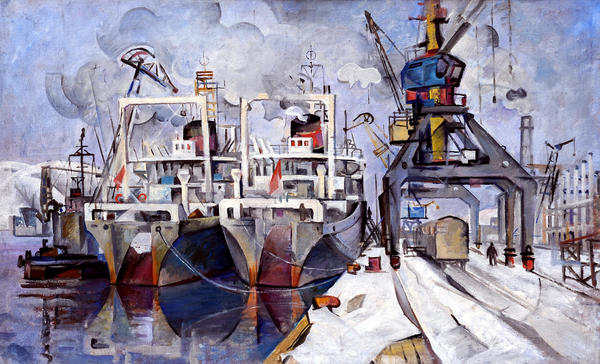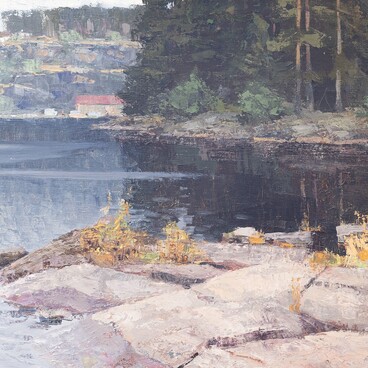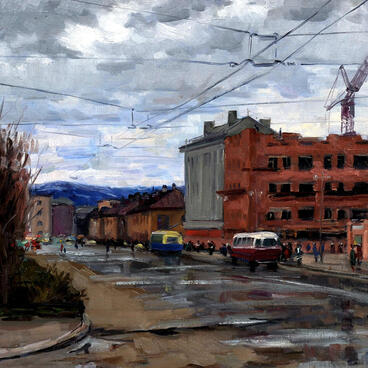The painter German Andreevich Shemyakin has been a member of the Union of Artists of the USSR since 1971. Born on June 7, 1938 in Murmansk. In 1959, he graduated from the Kazan Art College as a teacher of drawing and drafting.
The artist not only dedicated beautiful paintings to his small homeland, but also became the author of the famous badges “Feast of the North”, “Murmansk” and “North.”
The works of German Shemyakin are housed in the Murmansk Regional Art Museum, the Murmansk Regional Museum of Local Lore and in private collections.
German Shemyakin creates paintings using vibrant colors. One of his works is “The New Port”. Before starting work, the artist spent a lot of time in the port, studying the atmosphere and the scenery. The ships in this picture are skillfully connected to look like a single whole.
The Murmansk fishing port started as a number of fishing villages that the first settlers founded on the Murmansk coast as early as the 16th century. There was a need for special places where fishing vessels could wait out the bad weather, unload the caught fish, and replenish the necessary fishing gear, salt, fresh water and food. In September 1915, a temporary pier was erected, where the steamship “Drott” moored. A year later, the city of Romanov-on-Murman was founded. Later it was renamed to Murmansk.
Murmansk gave Russia access to the Atlantic Ocean, as well as the opportunity to explore the Arctic and travel across the Arctic Ocean along the Northern Sea Route. During the war years, the port became a reliable support base for the defense of the Arctic and the main channel delivering goods.
In the post-war period, the ports of Murmansk increased the volume of cargo turnover, were reconstructed and expanded several times. Machinery made much of the work at the port more efficient.
In 1971, the Murmansk Sea Fishing Port had about 140 units of various handling equipment, 62 of which were cranes. Giant gantry cranes of the Murmansk Commercial Sea Port have long been the hallmark of Murmansk. These machines have served as a source of inspiration for artists and photographers working in various genres for many years.
The artist not only dedicated beautiful paintings to his small homeland, but also became the author of the famous badges “Feast of the North”, “Murmansk” and “North.”
The works of German Shemyakin are housed in the Murmansk Regional Art Museum, the Murmansk Regional Museum of Local Lore and in private collections.
German Shemyakin creates paintings using vibrant colors. One of his works is “The New Port”. Before starting work, the artist spent a lot of time in the port, studying the atmosphere and the scenery. The ships in this picture are skillfully connected to look like a single whole.
The Murmansk fishing port started as a number of fishing villages that the first settlers founded on the Murmansk coast as early as the 16th century. There was a need for special places where fishing vessels could wait out the bad weather, unload the caught fish, and replenish the necessary fishing gear, salt, fresh water and food. In September 1915, a temporary pier was erected, where the steamship “Drott” moored. A year later, the city of Romanov-on-Murman was founded. Later it was renamed to Murmansk.
Murmansk gave Russia access to the Atlantic Ocean, as well as the opportunity to explore the Arctic and travel across the Arctic Ocean along the Northern Sea Route. During the war years, the port became a reliable support base for the defense of the Arctic and the main channel delivering goods.
In the post-war period, the ports of Murmansk increased the volume of cargo turnover, were reconstructed and expanded several times. Machinery made much of the work at the port more efficient.
In 1971, the Murmansk Sea Fishing Port had about 140 units of various handling equipment, 62 of which were cranes. Giant gantry cranes of the Murmansk Commercial Sea Port have long been the hallmark of Murmansk. These machines have served as a source of inspiration for artists and photographers working in various genres for many years.



